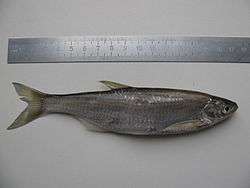Common bleak
The common bleak (Alburnus alburnus) is a small freshwater coarse fish of the cyprinid family.[1]
| Bleak | |
|---|---|
| Scientific classification | |
| Kingdom: | Animalia |
| Phylum: | Chordata |
| Class: | Actinopterygii |
| Order: | Cypriniformes |
| Family: | Cyprinidae |
| Subfamily: | Alburninae |
| Genus: | Alburnus |
| Species: | A. alburnus |
| Binomial name | |
| Alburnus alburnus | |
| Synonyms | |
| |
Description

The body of the bleak is elongated and flat. The head is pointed and the relatively small mouth is turned upwards. The anal fin is long and has 18 to 23 fin rays. The lateral line is complete. The bleak has a shiny silvery colour; and the fins are pointed and colourless. The maximum length is approximately 25 cm.
In Europe the bleak can easily be confused with many other species. In England, young common bream and silver bream can be confused with young bleak, though the pointed upward turned mouth of the bleak is already distinctive at young stages. Young roach and ruffe have a wider body and a short anal fin.
Occurrence
The bleak occurs in Europe and Western Asia: north of the Caucasus, Pyrenees and Alps, and eastward toward the Volga basin northern Iran and North-Western Turkey. It is absent from Iberian and Apennine peninsulas, from the rivers of Adriatic watershed on the Balkans and most of British Isles except southeast England. It is however locally introduced in Spain, Portugal, and Italy.
Ecology
The bleak lives in great schools and feeds upon small molluscs, insects that fall in the water, insect larvae, worms, small shellfish and plant detritus. It is found in streams and lakes. The bleak prefers open waters and is found in large numbers where there is an inflow of food from pumping stations or behind weirs.
Spawning
The bleak spawns near the shore in shallow waters. Some are found in deep water. The substrate is not important.
Importance
The bleak is an important food source for predatory fish. It is more sensitive to pollution than other cyprinids, which might explain the decline in North-Western Europe.
Uses
Bleak are used as bait for sport-fishing for larger fish. In 1656 in Paris, a Mr. Jaquin extracted from the scales of the common bleak, so-called "Essence Orientale"[1] or "pearl essence",[2] (used in making artificial pearls) which is crystalline guanine.[3]
References
- Chisholm, Hugh, ed. (1911). . Encyclopædia Britannica. 4 (11th ed.). Cambridge University Press. p. 55.
- Johann Rudolf von Wagner, Ferdinand Fischer, and L. Gautier, Traité de chimie industrielle (Treatise on industrial chemistry), 4th ed., (Paris, France: Masson & Co., 1903), vol. 2, pp. 64–65.
- In 1861 the French chemist Charles-Louis Barreswil (1817–1870) found that "pearl essence" was guanine. See: Barreswil (1861) "Sur le blanc d'ablette qui sert à la fabrication des perles fausses" (On the white of ablette that's used in making imitation pearls), Comptes rendus, 53 : 246.
| Wikimedia Commons has media related to Alburnus alburnus. |
- Freyhof, J. & Kottelat, M. (2008). "Alburnus alburnus". IUCN Red List of Threatened Species. 2008: e.T789A13079658. doi:10.2305/IUCN.UK.2008.RLTS.T789A13079658.en. Retrieved 13 January 2018.
- "Alburnus alburnus". Integrated Taxonomic Information System. Retrieved 24 January 2006.
- Froese, Rainer and Pauly, Daniel, eds. (2005). "Alburnus alburnus" in FishBase. 10 2005 version.
